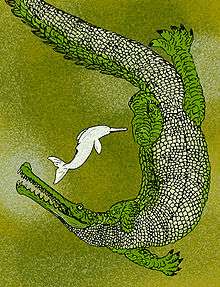Rhamphosuchus
Rhamphosuchus ("Beak crocodile") is an extinct relative of the modern false gharial. It lived during the Miocene and its fossils have been found in two regions; the Siwalik Hills of Pakistan and India as well as the Sindh region of Pakistan. It is only known from incomplete sets of fossils, mostly teeth and skulls. Four species belonging into the genus Gavialis may be included.
| Rhamphosuchus Temporal range: Miocene | |
|---|---|
 | |
| Scientific classification | |
| Kingdom: | Animalia |
| Phylum: | Chordata |
| Class: | Reptilia |
| Order: | Crocodilia |
| Family: | Gavialidae |
| Subfamily: | Tomistominae |
| Genus: | †Rhamphosuchus Falconer & Cautley, 1840 |
| Type species | |
| †Rhamphosuchus crassidens Falconer & Cautley, 1840 | |
Overview

Traditionally, many palaeontologists estimated that it was one of the largest, if not the largest crocodylian that ever lived, reaching an estimated length of 15 to 18 m (49 to 59 ft).[1] However, a more recent study suggests that the animal may have been 8–11 m (26 to 36 ft) in length, and therefore is not the largest known crocodylian.[2] Another crocodylian, Purussaurus, from the Miocene of Peru and Brazil, is known from an equally incomplete fossil set. It is estimated to have been similar in length to the initial estimates at approximately 12 m (about 40ft). However, this would mean that it would have been somewhat larger in size if the more recent size estimates for Rhamphosuchus are correct. If the most recent estimate is correct, then several other extinct crocodylians also surpassed Rhamphosuchus in length, such as the Late Cretaceous alligatoroid Deinosuchus, the Early Cretaceous pholidosaurid Sarcosuchus, the Miocene gavialid Gryposuchus and the strange planktivorous Mourasuchus (a contemporary of Purussaurus), at 12 m, 9.5 m, 10.15 m, and 12 m, respectively.
Rhamphosuchus probably had a more generalized predatory diet than the piscivory of other tomistomines.[2]
References
- Heilprin, Angelo (1974). The Geographical and Geological Distribution of Animals: The International Science Series Vol. 57. Ayer Publishing. ISBN 0-405-05742-3.
- Head, J. J. (2001). "Systematics and body size of the gigantic, enigmatic crocodyloid Rhamphosuchus crassidens, and the faunal history of Siwalik Group (Miocene) crocodylians". Journal of Vertebrate Paleontology. 21 (Supplement to No. 3): 59A. doi:10.1080/02724634.2001.10010852.